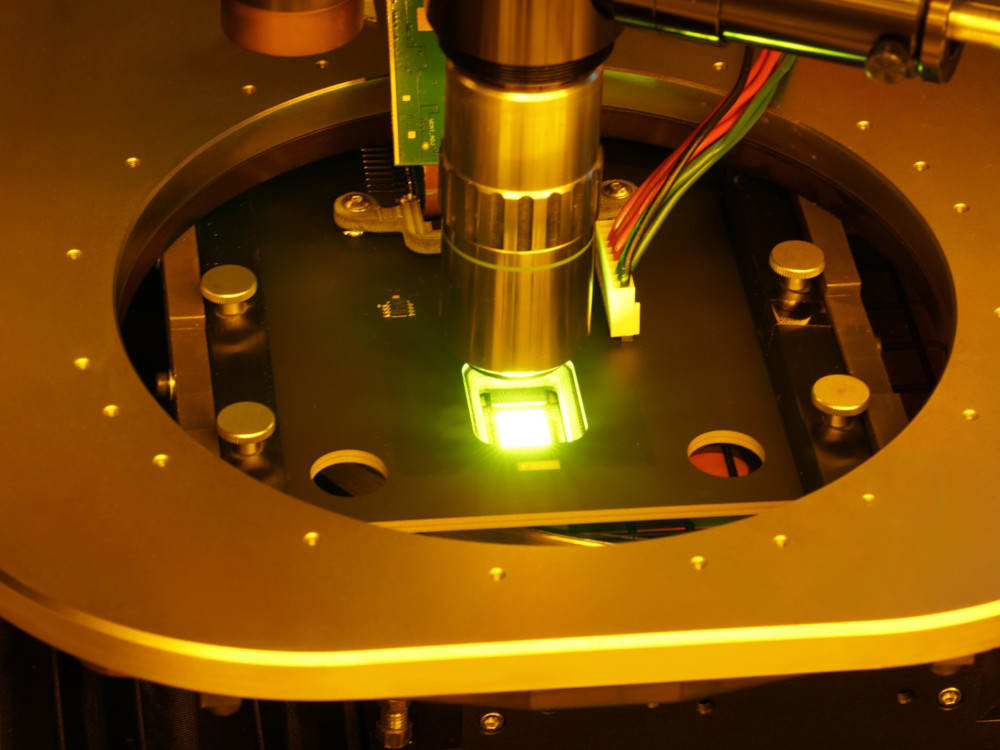
20 Jan Exceptionally bright microdisplays through stacked OLEDs
A highly efficient, monochrome OLED microdisplay with a brightness of over 70,000 nits has been developed by researchers at the Fraunhofer Institute for Photonic Microsystems IPMS. The stack of organic light-emitting diodes that is used even achieves even than 200,000 nits on reference substrates. The microdisplay will be presented for the first time at SPIE AR VR MR 2025 from January 28 to 29 in San Francisco.
Especially users of data glasses for augmented reality (AR) need particularly bright displays in daylight in order to be able to see content clearly. High brightness and low power consumption are therefore key development goals, as optical systems – such as AR glasses – have high brightness losses and portable devices are limited by battery storage.
Highest brightness or longer lifetime
Johannes Zeltner, PhD student at Fraunhofer IPMS: “This outstanding brightness was achieved by stacking OLED layers.” Zeltner explains: “The individual OLED units are connected in series, which increases the brightness with each additional unit without raising the current density in the component. This can be used either to achieve extremely high brightness levels or, at a given brightness, to significantly reduce the current density that determines the lifetime. Measurements have shown that in a comparison between a 1-unit and 2-unit OLED, the LT95 service life, i.e. the drop in brightness by five percent, can be significantly improved from 900 to 1300 hours at 50,000 nits.”
The challenge of stacked OLEDs
According to the researchers, the power efficiency and brightness of 1-, 2- and 3-fold stacked OLEDs were first evaluated on passive test substrates and then successfully transferred to 0.62-inch CMOS backplanes with SXGA resolution. This revealed new challenges for further research: while the distance between the subpixels in conventional OLED displays is often several tens of micrometers, in microdisplays it is only a few hundred nanometers. This can lead to crosstalk between neighboring pixels with thicker layer stacks and multiple stacked OLEDs in microdisplays. According to the development team, solutions to reduce this crosstalk are in preparation.
Advantage: narrow-band emission
The researchers also report that the work has shown that narrow-band emission with high brightness is possible through multiple stacking. This should allow the spectral emission to be specifically adapted and enable the use of optical concepts with special requirements, such as waveguides or holographic elements.
Improvements and marketability
The team of develpers is convinced that the ongoing development towards ever higher brightness and improved lifetimes will secure OLED technology a firm place in the field of AR applications. Nevertheless there is a continuous need for research, for example on optical crosstalk, improved OLED materials and novel backplane architectures.
The researchers are pleased to be able to offer the achieved results as well as research services to interested partners worldwide in order to take OLED microdisplay technology to the next level and integrate it into marketable products.
SPIE AR VR MR 2025
Fraunhofer Institute for Photonic Microsystems IPMS
Booth 6202
Source and image: www.ipms.fraunhofer.de






